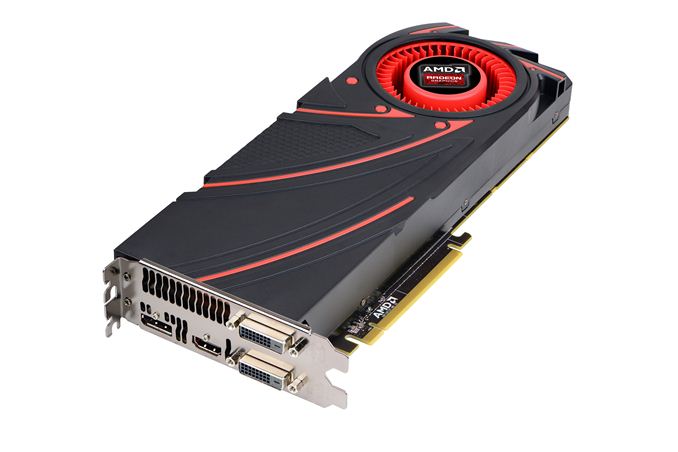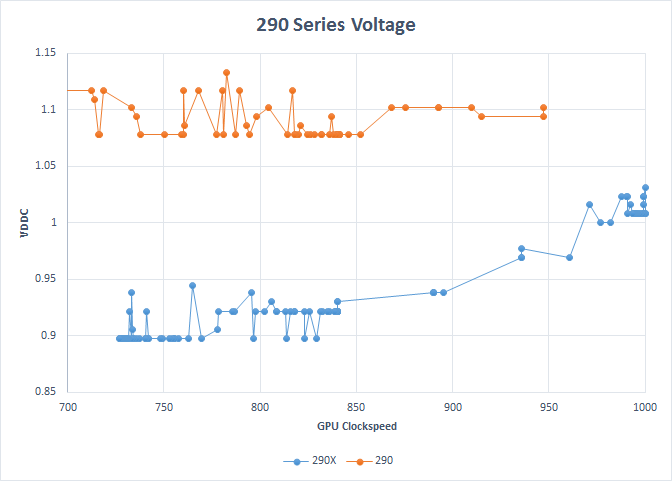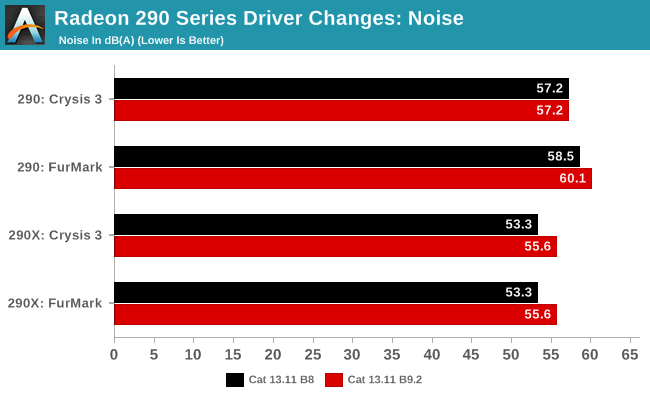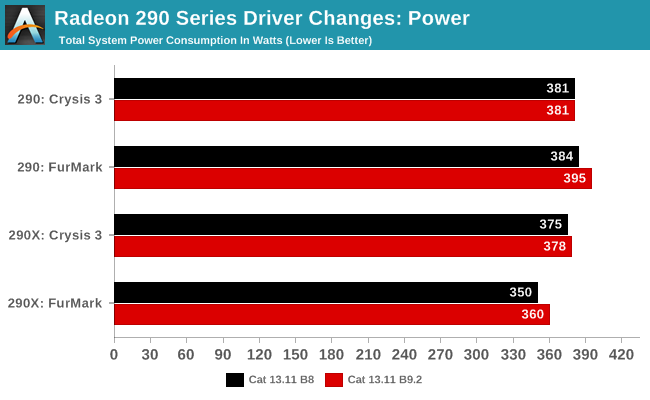AMD Changes 290 Series Fan Algorithms & About That 290 Conclusion
by Ryan Smith on November 9, 2013 3:48 PM EST- Posted in
- GPUs
- AMD
- Radeon
- Radeon 200

In a busy week that’s going to end up being just a bit busier, AMD has pushed out another Catalyst driver update specifically targeted at the new Radeon R9 290 series, Catalyst 13.11 Beta9.2. This release is especially notable because it resolves some outstanding issues with the hardware that the hardware press has covered in depth this week opposite the 290 launch, and because it is making low level operational changes that will have a direct impact on the power, noise, and performance characteristics of the 290 series.
First off, let’s talk about what AMD has done with their drivers. Citing an issue with variability in the fan speeds on 290 series cards, AMD has changed the algorithms for how their drivers handle the fan speeds on 290 series cards, essentially overriding the BIOS defaults with new values. This is similar to how AMD deployed their specification changes for the 290 ahead of its launch – adjusting it from 40% to 47% as the default maximum fan speed – but AMD has also used their driver update to change how they’re defining and controlling fan speeds.
Rather than controlling fan speed based on percentages, which are really measuring fan speed as the duty cycle of the fan’s motor on a relative basis, AMD has switched to controlling fan speeds on an absolute basis, using the measured RPM of the fan as their metric of absolute fan speed. This goes back to AMD’s concern over variance, as there is going to be some variance – and apparently too much variance – from fan motor to fan motor in how fast it can go, and consequently just what a specific duty cycle represents on a relative basis. Consequently by switching to measuring fan speed on an absolute basis there will definitely be less variation. as AMD is now controlling fan speeds by the very same metric they use to define that variation (RPM).
For the release of this driver, this is what AMD specifically had to say.
We’ve identified that there’s variability in fan speeds across AMD R9 290 series boards. This variability in fan speed translates into variability of the cooling capacity of the fan-sink.
The flexibility of AMD PowerTune technology enables us to correct this variability in a driver update. This update will normalize the fan RPMs to the correct values.
Given the significant interest there has been this week in articles published over at Tom’s Hardware and their experience with additional retail 290 series cards, it's likely that this is related to the issues Tom’s was seeing. In which case the implication is that fans are running too slow, which could've definitely resulted in lower performing cards. It's obviously also possible that fans could be running too fast in some configurations, which would obviously result in louder/higher performing cards. The third scenario that this update corrects is one that AMD told us about: where the fans are running too slow during light-to-medium workloads, which in turn allows the GPU to heat up more than it should and forces the fan to run at higher speeds down the line. In this third scenario, the overall acoustic profile of the card would actually be quieter post update. Admittedly this isn't something we test for or something we've seen internally, but it's a situation that AMD says also improves with this update.
Along with reducing variation the net result of this driver as far as our samples are concerned will be that fan speeds are going to go up. AMD’s new maximum fan speeds for the 290X (quiet mode) and 290 will be 2200RPM and 2650RPM respectively. A quick meta-analysis doesn’t show any site as having reported their review samples as having RPMs that high or higher, in which case the situation should be similar to ours. Our cards topped out at 2100RPM for the 290X and 2500RPM for the 290, so these new values represent a 100RPM and 150RPM increase in default fan speeds respectively. Or on a percentage basis, we’ve gone from 40% to 42% for the 290X, and 47% to 49% for the 290.
| AMD Radeon R9 290 Series Maximum Fan Speeds | |||||||||||
| Card | Catalyst 13.11 Beta 8 | Catalyst 13.11 Beta 9.2 | |||||||||
| 290X (Quiet Mode) | ~2100 RPM (40%) | ~2200RPM (42%) | |||||||||
| 290 | ~2500 RPM (47%) | ~2650 RPM (49%) | |||||||||
Since we don’t have any other 290 cards at this time, and our second 290X already behaved virtually identical to our first, we’re not in a position to talk about the matter of variance in further detail. Presumably variance was a big enough issue that it required AMD’s quick attention, but we don’t have any further cards to get a first-hand impression of just how large that variance was. Whatever the variance was though, this should virtually eliminate it.
What we can briefly look at however is how this changed our performance results. The net effect of this change is that AMD has increased their fan speeds for the 290 series, and as a result noise levels are going to go up slightly, and due to the close relationship between noise, cooling, and heat dissipation, power consumption will also go up slightly too. We’d say performance is going to go up too (again similar to the 290’s spec change), but in reality the amount of variance caused by PowerTune has all but drowned out any possible performance difference on our 290X. Meanwhile our 290 wasn’t cooling limited in the first place, so this change hasn’t affected gaming performance.
With respect to PowerTune on the 290X, we’ve been finding that PowerTune adjusts clockspeeds rather significantly in response to the smallest input changes, which makes it difficult to isolate any resulting performance changes from the fan speed adjustment. The reason why this is happening is unclear, but we suspect that it has to do with the 290 series cards not having much flexibility to adjust their voltages, resulting in them having to instead widely adjust their clockspeeds to achieve the necessary reduction in power consumption and heat generation.
To put this concept to the test, here are some quick scatter plots of the 290 and 290X running FurMark, plotting clockspeed against voltage (VDDC) as measured by GPU-Z. These voltages are going to be subject to external factors such as vDroop, but it’s the best we have right now since we can’t see VIDs.

In brief, there’s only roughly a 100mv difference in voltages between the 290X’s base clockspeed and boost clockspeed, and even less a difference on the 290. If this data is reasonably accurate, then it would explain why the 290 series sees such heavy clockspeed throttling at times, and why our gaming performance hasn’t changed. So with that in mind, let’s look at the numbers.

First and foremost, noise under load has predictably gone up. For the 290X where FurMark and Crysis 3 top out at the same point, this new noise level is 55.6dB, 2.3dB higher than the old maximum of 53.3dB. For the 290 on the other hand, noise levels don’t change under Crysis 3 since it wasn’t cooling/fan limited in the first place, remaining at 57.2dB. However the worst case scenario, as represented by FurMark, sees noise levels increase a further 1.6dB to 60.1dB.

As for power consumption, since we’re clearly cooling limited in most scenarios on the 290 series, any increase in cooling performance causes an increase in power consumption. For the 290X in FurMark this is another 10W at the wall, while under Crysis 3 (where performance is nearly identical) this is a barely measurable 3W difference. While for the 290 the difference is 11W for FurMark, and absolutely nothing for Crysis 3 since it wasn’t cooling limited in the first place.

Finally for performance, we can see that the fan speed adjustments had no measurable impact on performance under Crysis. The 290 was never cooling limited in the first place, and for the voltage issues discussed further, PowerTune has all but wiped out any potential performance improvement for the 290X, leaving it changed by a fraction of a frame per second. Unfortunately this means the noise increase is very real, but there’s not a measurable performance increase to go with it.
With all of that said, this won’t be impacting our reviews of the 290 or 290X (or GTX 780 Ti), as there isn’t a performance change to account for, and the noise change, though unfortunate, is under gaming workloads limited to the 290X (though this does mean 290X loses some further ground to 290).
About that 290 Conclusion
Since we’re already on the matter of our recommendations, I wanted to spend a bit of time following up on our 290 review, as that review and its conclusion generated a lot more feedback than we had been expecting. In this week’s article I flat out avoided recommending the 290 because of its acoustic profile. When faced with the tradeoff of noise vs. performance, AMD clearly chose the latter and ended up with a card that delivers a ridiculous amount of performance for $399 but exceeds our ideas of comfortable noise levels in doing so.
I personally value acoustics very highly and stand by my original position that the reference R9 290 is too loud. When I game I use open back headphones so I can listen for phone calls or the door for shipments, and as a result acoustics do matter to me. In the review I assumed everyone else valued acoustics at least similarly to me, but based on your reaction it looks like I was mistaken. While a good number of AnandTech readers agreed the R9 290 was too loud, an equally important section of the audience felt that the performance delivered was more than enough to offset the loud cooling solution. We want our conclusions to not only be reflective of our own data, but also be useful to all segments of our audience. In the case of the 290 review, I believe we accomplished the former but let some of you down with the latter.
Part of my motivation here is to make sure that we send the right message to AMD that we don’t want louder cards. I believe that message has been received loud and clear from what I understand. It’s very important to me that we don’t send the message to AMD or NVIDIA that it’s ok to engage in a loudness war in the pursuit of performance; we have seen a lot of progress in acoustics and cooler quality since the mid-to-late 2000’s, and we’d hate to see that progress regressed on. A good solution delivers both performance and great user experience, and I do believe it’s important that we argue for both (which is why we include performance, power and noise level data in our reviews).
The Radeon R9 290 does offer a tremendous value, and if you’re a gamer that can isolate yourself from the card’s acoustics (or otherwise don’t care) it’s easily the best buy at $399. If acoustics are important to you, then you’re in a tougher position today. There really isn’t an alternative if you want R9 290 performance at the same price. The best recommendation I have there is to either pony up more cash for a quieter card, accept the noise as is or wait and see what some of the customized partner 290 cards look like once those do arrive. I suspect we’ll have an answer to that problem in the not too distant future as well.
Note that this isn't going to be the last time performance vs. acoustics are going to be a tradeoff. AMD pointed out to us that the 290/290X update is the first time its fan speed has been determined by targeting RPMs vs. PWM manipulation. In the past, it didn't really matter since performance didn't scale all that much with fan speed. Given the current realities of semiconductor design and manufacturing, the 290/290X situation where fan speed significantly impacts performance is going to continue to be the case going forward. We've already made the case to AMD for better reference cooling designs and it sounds like everyone is on the same page there.
Given the amount of interest this has generated I'm curious to get your feedback on the performance vs. acoustic debate. Feel free to share your comments below on how important acoustics are for you (vs. performance) and at what point does a GPU become too loud? For us the reference point was NVIDIA's GeForce GTX 480, but I'm interested to know what GPUs in your past have been too loud.










141 Comments
View All Comments
Lonyo - Sunday, November 10, 2013 - link
1) Ryan should be allowed to have his own opinion on the card and express that in his review2) Ryan's opinion should not dictate the conclusion of the review
3) This is not a failure of Ryan for having an opinion, this is a failure of the editorial process to not pick up on how opinionated the review came due to Ryan's focus on noise above other factors.
The review should have been fine first time round with better editorial control to temper/balance out Ryan's conclusion, but it seems that this was lacking in the review. It also seems to be lacking in the 780Ti review, which talks about the HD290X vs 780Ti while failing to mention the key difference between the cards, being $100.
In the 290 review, there is clear discussion of price differences and performance difference, and whether value for money is offered.
In the 780Ti review, there is no discussion of whether it is worth its premkium over the 290 cards of the 780.
These are the sorts of things that the editor should be catching to improve the quality of articles, so that this sort of post-review acknowledgement of the original review does not need to be made.
The Von Matrices - Sunday, November 10, 2013 - link
The 780Ti was explained many times in the review to be a card that is outside of the price/performance chart. It is the flagship product and not meant to have be a value proposition at all. The conclusion clearly states:"At $700 it’s by no means cheap – and this has and always will be the drawback to NVIDIA’s flagships so long as NVIDIA can hold the lead – but it also means that NVIDIA does need to take AMD’s Radeon R9 290 series into account. As such the 290X and the GTX 780, though lesser performing parts, will remain as spoilers for GTX 780 Ti due to their better balance of performance and pricing. All the while GTX 780 Ti stands at the top of the heap for those who want the best."
A5 - Sunday, November 10, 2013 - link
So you're saying that Ryan should have to write the entire review, and then change the conclusions to match some nebulous general opinion instead of what he really thinks?I already know that nobody on this site reads bylines (see: almost every comment on the R290 review being addressed to Anand instead of Ryan), but they're there for a reason.
Laststop311 - Sunday, November 10, 2013 - link
Noise is very important to me. I leave my pc on 24/7 and it's right next to my bed so you best believe I pick all my components based on noise first and foremost. For any like minded readers like me this is my recommendation.If you only game at 1920x1080 and want a solid 60 fps with ultra details for current and near future games the GTX 760 is the best choice. If you want something that will be more future proof for this scenario pony up the extra 80 dollars and get the GTX 770.
If you game at 2560x1600/1440 and want a solid 60 fps with ultra details probably 95-97% of games will run like this with a GTX 780 and I would solidly recommend that over the GTX 780ti which is a whole 200 dollars over.
If you want to game on a 3840x2140 (4k) resolution there is currently no card that can sustain that res on ultra details at 60fps. I recommend 2x GTX 780 in SLI for this resolution. 2x GTX 780ti is overkill and the regular 780 in SLI will be enough.
Laststop311 - Sunday, November 10, 2013 - link
Unfortunately when I got my dell u3014 and my radeon 5870 was no longer cutting it my options were GTX 680 or GTX titan or radeon 7970 so the only card that gave the performance I needed was 1049 dollars. I probably could of skated by with the gtx 680 but the titan had just come out and i do like to contribute to folding @ home and things like that and loan my processing power out. Got a good 9 months of having the top performing single card which is pretty good in the pc world. There are some situation where the titan does drop below 60 fps but I wont be upgrading till maxwell comes out. Hopefully a nice 2560x1600 30 inch with gsync becomes available around the time maxwell does. That will be a potent combination.terabaSe - Sunday, November 10, 2013 - link
Just get a Gigabyte Windforce edition. The 3x will do, they run silent and cool and they tend to be very cost effective. My last 4 cards, a mix of AMD and NVIDIA have all been those and you never have to worry about noise or temps again...varad - Sunday, November 10, 2013 - link
Ryan,I loved your initial conclusion and acoustics is definitely high on my priority list.
I am guessing there are more people like me who do not generally write comments and mostly just read the reviews on various tech sites [like AT]. And to be honest, I come here to read your honest view/opinion and not something that is written to appease everyone [like the kind of balancing act being done in this article]. So, please do include your personal views in future reviews.
Thanks!
PolarisOrbit - Sunday, November 10, 2013 - link
I have often felt that reviewers don't put enough value on non-performance based specs. Sound is the most relevant one for video cards, but for other types of products it can be battery life or temperature that is the relevant secondary characteristic.However, reading the conclusion on for the R290, it felt unfair to pan the whole product because it failed one area. If performance is good and price/performance is good that's an automatic rubber stamp of approval. The best way to handle it would have been to give a big caveat where there's a gaping hole in the product's overall value.
The way I rate video cards is like this (descending importance):
1) Price [I'm not going above $200]
2) Brand rotation [I have to alternate Nvidia and AMD so I have reasonably new versions of each brand for testing purposes]
3) Price/Performance
4a) DX/OGL support level
4b) Acoustics
4c) Secondary features [CUDA, Eyefinity, etc.]
5) Bundles
Death666Angel - Sunday, November 10, 2013 - link
Great post!Like I said in a comment under the 290 article: I don't care about reference design loudness. If I buy a reference design card, it is because I will swap the cooler for an aftermarket solution like the Arctic Accelero stuff or (in my case) a water cooling block. If I buy a card for use as is, I wait for custom stuff like the Lightning series from MSI or the new Gigabyte OC'ed things. They are a bit pricier usually, but offer enough extras to justify it and in my experience, achieve better overclocks. And when I game I have my headset on (not noise cancelling) and don't hear anything of the PC anyway.
Kougar - Sunday, November 10, 2013 - link
Since you asked for opinions... Acoustics are important to me, but in the case of the 290 specifically they wouldn't matter. From my point of view (assuming I was presently in the market) I would be buying a waterblock for the GPU regardless. So having the 290 offer such good value with a cheap cooler is great, because I'd be replacing it anyway. Watercooling would easily tame such a card and let it offer max performance all the time.As a GTX 480 FTW Hydrocopper owner I am very aware of what a good WC setup can do to incredibly hot/loud cards. Max performance, longevity, slightly lower power consumption, and most of all silent acoustics.... Been running it 24/7 folding with an overclock since day one and it's still running strong.